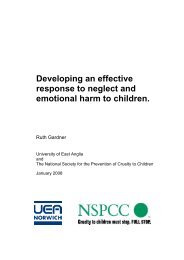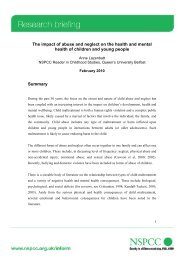A qualitative study of children, young people and 'sexting ... - NSPCC
A qualitative study of children, young people and 'sexting ... - NSPCC
A qualitative study of children, young people and 'sexting ... - NSPCC
Create successful ePaper yourself
Turn your PDF publications into a flip-book with our unique Google optimized e-Paper software.
A <strong>qualitative</strong> <strong>study</strong> <strong>of</strong> <strong>children</strong>, <strong>young</strong> <strong>people</strong> <strong>and</strong> ‘sexting’<br />
<strong>and</strong> gender positionings in relation to ‘sexting’. This in turn, it is hoped, will enable development <strong>of</strong><br />
appropriate resources to support different groups <strong>of</strong> <strong>young</strong> <strong>people</strong> the better to avoid or deal with<br />
‘sexting’ ins<strong>of</strong>ar as this is problematic for them.<br />
putting concerns over sexting into context – the ‘sexualisation’<br />
<strong>of</strong> culture<br />
The ‘sexualisation <strong>of</strong> culture’ has become a major focus <strong>of</strong> interest <strong>and</strong> concern in the last decade (e.g.<br />
McNair, 2002; Gill, 2003; McRobbie, 2004; Levy, 2005; Paasonen et al., 2007; Attwood, 2009; Durham,<br />
2009; Levin & Kilbourne, 2009; Dines, 2010). The phrase is used to capture the growing sense that<br />
western societies have become saturated by sexual representations <strong>and</strong> discourses, with pornography<br />
increasingly influential <strong>and</strong> porous, permeating contemporary culture. Porn stars have emerged as<br />
bestselling authors <strong>and</strong> celebrities; a ‘porno chic’ aesthetic can be seen in music videos <strong>and</strong> advertising;<br />
<strong>and</strong> practices once associated with the sex industry e.g. lapdancing <strong>and</strong> pole dancing have become newly<br />
‘respectabilised’, promoted as mainstream corporate entertainment or fitness activity. This shift speaks to<br />
something more than the idea that ‘sex has become the big story’ (Plummer, 1995:4) but denotes a range<br />
<strong>of</strong> different things:<br />
‘a contemporary preoccupation with sexual values, practices <strong>and</strong> identities; the public shift to more<br />
permissive sexual attitudes; the proliferation <strong>of</strong> sexual texts; the emergence <strong>of</strong> new forms <strong>of</strong> sexual<br />
experience; the apparent breakdown <strong>of</strong> rules, categories <strong>and</strong> regulations designed to keep the<br />
obscene at bay; [<strong>and</strong> the] fondness the sc<strong>and</strong>als, controversies <strong>and</strong> panics around sex’ (Attwood,<br />
2006: 77).<br />
Brian McNair (2002) has argued Western society has become a ‘striptease culture’ preoccupied with<br />
confession, revelation <strong>and</strong> exposure. This is connected to an ongoing breakdown or renegotiation <strong>of</strong><br />
the boundary between public <strong>and</strong> private, which is itself the outcome <strong>of</strong> multiple, intersecting factors<br />
including the partial success <strong>of</strong> the women’s <strong>and</strong> sexual liberation movements, shifts in media regulation<br />
away from censorship <strong>and</strong> towards ‘an informed consumer model’ (Bragg & Buckingham, 2009), <strong>and</strong><br />
the possibilities opened up by rapid technological change. More broadly, sociologists would situate<br />
claims about ‘sexualisation’ within the wider canvas <strong>of</strong> developments in advanced capitalism in which<br />
relationships are taking on more fluid <strong>and</strong> ‘liquid’ forms (Bauman, 2003), intimacy is transforming<br />
(Beck & Beck-Gernsheim, 1995), <strong>and</strong> sex is playing a more central role in ‘projects <strong>of</strong> the self ’ (Giddens,<br />
1993; Featherstone, 1990; 1999).<br />
Growing concerns about ‘sexualization’ can be seen in the UK coalition government’s renewed emphasis<br />
on child ‘sexualisation’ <strong>and</strong> ‘commercialisation’ as a key areas to be addressed (DCMS, 2010; DfE, 2010;<br />
HM Government, 2010) .The proliferation <strong>of</strong> public <strong>and</strong> policy reports includes, in the last two years<br />
in Britain alone, a Home Office report by Dr Linda Papadopoulos (Papadopoulos, 2010; see also APA,<br />
2007), a report commissioned by the Scottish Office (Buckingham et al., 2010) <strong>and</strong>, most recently,<br />
Reg Bailey’s (2011) report Let Children be Children (this building on the Byron Review, 2008, which<br />
examined ways <strong>of</strong> helping <strong>young</strong> <strong>people</strong> safely cope with increasing exposure to <strong>and</strong> use <strong>of</strong> sexually<br />
explicit materials via new media technologies). It is also seen in a plethora <strong>of</strong> popular books, about the<br />
sexualisation <strong>of</strong> girls, with titles such as So Sexy, So Soon or What’s happening to our Girls? Stories about<br />
‘sexualisation’ also form an increasing proportion <strong>of</strong> news items, <strong>and</strong> it is clear that the topic is given<br />
prominence by editors as a matter <strong>of</strong> major public interest.<br />
16
















